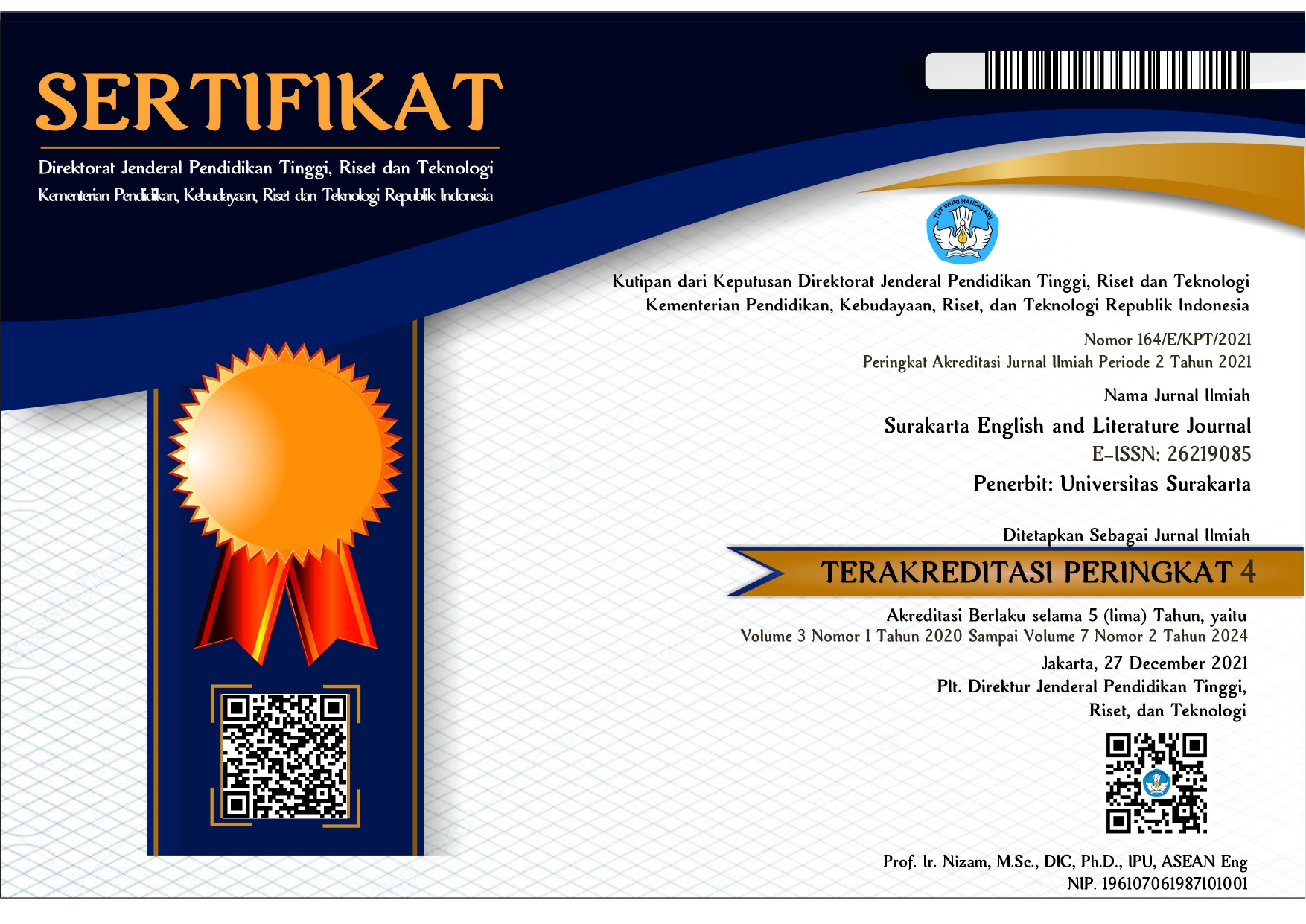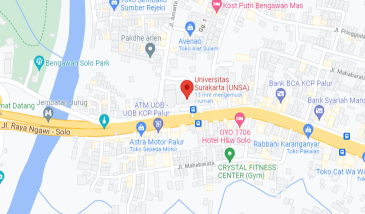Code Switching on “Catch Me Up!”: A New Style of News Writing?
DOI:
https://doi.org/10.52429/selju.v7i2.237Keywords:
news-writing style, Catch Me Up!, code-switching, digital mediaAbstract
News writing is generally formulated using a standard, formal language style. However, Catch Me Up!, an online daily newspaper, broke those strict rules by offering casual, loose, non-standard language which predominantly used code-switching as one of the ways to alter formal to informal language styles. Hence, this study aimed to describe the various types of code-switching that occurred on Catch Me Up! and explain why the news frequently employed code-switching. Three theories underlie the present research; types of code-switching by Poplack and a combination of reasons for code-switching by Hoffmann, Gumperz, and San. The study applied the descriptive-qualitative method since the data were in the form of words, phrases, clauses, and sentences. The data sources were taken from 17 international news published in July 2023. The results revealed that, out of 235 found data, intra-sentential switching became the most occurred data regarding code switching types. In line with the reasons for code-switching, addressee specification and expressing group identity appeared dominantly in this study, followed by talking about a particular topic, interjection, indicating emotions, intention for clarifying the speech substance for interlocutors, and quoting somebody else.
References
Adhi, I. S. (2023, July 18). Rusia Klaim Jatuhkan 28 Drone di Atas Crimea. Kompas.Com. https://www.kompas.com/global/read/2023/07/18/170000870/rusia-klaim-jatuhkan-28-drone-di-atas-crimea
Admin. (2023, June 27). Wagner Group Serang Balik Pemerintahan Rusia. Catch Me Up!
Afryanti, R., Daud, B., & Muthalib, K. A. M. (2021). A STUDY OF CODE-SWITCHING AND CODE-MIXING USED BY YOUTUBE CHANNELS: A COMPARISON OF INDONESIAN YOUTUBERS. English Education Journal, 12(3), 496–511.
Alaiyed, M. A. (2020). The Functions of Code-switching in the Interaction of the Cartoon Characters in Dora the Explorer. Arab World English Journal, 11(3), 260–275. https://doi.org/10.24093/awej/vol11no3.16
Appel, R., & Muysken, P. (1987). Language Contact and Bilingualism. Edward Arnold.
Auer, P. (1998). Code-Switching in Conversation: Language, Interaction, and Identity. Routledge.
Cresswell, J. W. (2014). Research Design: Qualitative, Quantitative, and Mixed Methods Approaches (4Th Edition). SAGE Publications.
Gardiner, I. A., & Deterding, D. (2017). English Medium Education in a University in Brunei Darussalam : Code-switching and Intelligibility English Medium Education in a University in Brunei Darussalam : Code-Switching and Intelligibility. https://doi.org/10.1007/978-3-319-51976-0
Girsang, M. L. (2015). An Analysis of Code Switching and Code Mixing as Found in Television Advertisement. Code Mixing and Code Switching Study, VII, 50–64.
Gumperz, J. J. (1982). Discourse Strategies. Cambridge University Press.
Halim, N. S., & Maros, M. (2014). The Functions of Code-switching in Facebook Interactions. Procedia - Social and Behavioral Sciences, 118, 126–133. https://doi.org/10.1016/j.sbspro.2014.02.017
Hoffmann, C. (1991). Introduction to Bilingualism. Routledge.
Kasim, U., Yusuf, Y. Q., & Ningsih, S. R. J. (2019). The types and functions of code-switching in a thesis defense examination. EduLite: Journal of English Education, Literature and Culture, 4(2), 101. https://doi.org/10.30659/e.4.2.101-118
Langit, A. N. S., Hikmah, I., & Surwanti, D. (2022). Code Switching and Code Mixing on “Ngobrol Sore Semaunya” Podcast. International Journal of English Learning and Applied Linguistics (IJELAL), 3(1), 1. https://doi.org/10.21111/ijelal.v3i1.7410
Muflihah. (2017). Code Switching dan Code Mixing dalam Komunikasi di Lingkungan Dosen IAIN Purwokerto (Suatu Kajian Sosiolinguistik). KOMUNIKA: Jurnal Dakwah Dan Komunikasi, 10(1), 94–107.
Muysken, P. (2000). Bilingual Speech: A Typology of Code-Mixing. Cambridge University Press.
Poplack, S. (1993). Variation Theory and Languages Contact. In D. Preston (Ed.),. In American Dialect Research (pp. 251–286). John Benjamins.
Rini, Natsir, M., & Setyowati, R. (2019). CODE SWITCHING IN DIOR AND I FILM. Asian Englishes, 3(1), 52–61. https://doi.org/10.1080/13488678.2012.10801322
Rosdalina, I. (2023, July 18). Ukraina Kehilangan 20 Persen Peralatan Militer dalam Serangan Balasan. Tempo. Co.
Rusydah, D. (2020). Bahasa Anak JakSel: A Sociolinguistics Phenomena. Litera Kultura, 8(1), 1–9.
Sarwono, S. (2014). Anak Jakarta. Wacana, Journal of the Humanities of Indonesia, 15(1), 41–65.
Setyaningsih, N., & Larassati, A. (2021). “Umm, you know…” Speaking or Writing?: Examining EFL Students’ Writing Style in Argumentative Essays. Elsya : Journal of English Language Studies, 3(1), 17–22. https://doi.org/10.31849/elsya.v3i1.5818
Shendykhatama, A. T., & Wardhono, A. (2022). An analysis of code-switching used in Cinta Laura Khiel podcast. Indonesian EFL Journal: Journal of ELT, Linguistics, and Literature, 8(2), 90–100.
Spradley, J. P. (2016). Participant Observation. Waveland Press.
Sumadiria, H. (2011). Jurnalistik Indonesia: Menulis Berita dan Feature Panduan Praktis Jurnalis Profesional. Simbiosa Rekatama Media.
Upa, R. (2014). Code Switching Types Used by the English Teacher in English Classroom at SMA I Malili. Ethical Lingua, 1(2), 44–58.
Wijaya, F. S. (2020). Kohesi Leksikal Wacana Berita Pelantikan Presiden Di Media Daring “Tempo.Co.” Mahakarya: Jurnal Mahasiswa Ilmu Budaya, 1(1). https://doi.org/10.22515/mjmib.v1i1.2700
Wulandari, D., & Susylowati, E. (2021). Code Switching and Code Mixing K-Popers EXOL In Social Media Twitter. Surakarta English and Literature Journal, 4(2), 66. https://doi.org/10.52429/selju.v4i2.682
Yuliana, N., Luziana, A. R., & Sarwendah, P. (2015). Code-Mixing and Code-Switching of Indonesian Celebrities: A Comparative Study. Lingua Cultura, 9(1), 47. https://doi.org/10.21512/lc.v9i1.761
Downloads
Published
Versions
- 2024-09-27 (2)
- 2024-09-03 (1)
How to Cite
Issue
Section
License
Copyright (c) 2024 Wildi Adila, Afika Hany Amalia, Lina Nur Aini, Sari Murni

This work is licensed under a Creative Commons Attribution-ShareAlike 4.0 International License.
Licensing for Data Publication
-
Open Data Commons Attribution License, http://www.opendatacommons.org/licenses/by/1.0/ (default)
-
Creative Commons CC-Zero Waiver, http://creativecommons.org/publicdomain/zero/1.0/
-
Open Data Commons Public Domain Dedication and Licence, http://www.opendatacommons.org/licenses/pddl/1-0/














